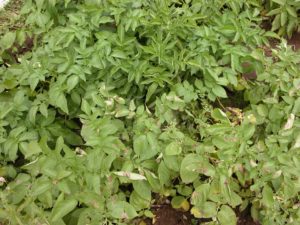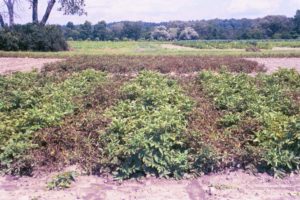Another Tool for your Disease Management Toolbox: Disease Resistant Varieties
Last summer’s tomato late blight epidemic may have been the first time many people heard about using resistant varieties to control disease. But what is disease resistance and how can it help small vegetable farmers and home gardeners?

Kennebec (top) is resistant to late blight of potatoes, while Adirondack Red (bleow) is susceptible. Courtesy of Chris Thompson.
What is disease resistance?
Disease resistance is a plant’s genetic ability to prevent a disease causing pathogen from causing damage to the plant. Some species develop resistance to diseases through natural selection. Many of the varieties available today have been bred to have resistance to one or more diseases combined with good yield and other desirable traits. If a variety is described as resistant then all the plants of that variety will be resistant to the diseases listed. Levels of disease resistance can vary from near immunity to a restriction in disease development. This depends on how the plant resists the disease and the genes involved.
Why should I use disease resistant varieties?
Disease resistance is one way to reduce reliance on pesticides to control diseases that reduce crop yields. It is rarely a stand-alone measure – it needs to be combined with cultural and environmental methods that reduce the potential for disease occurrence. And if disease pressure is very high, some pesticide use may be required.
If a plant is free of diseases, does that mean it is disease resistant?
Not necessarily. In order for disease to develop, the pathogen needs to be present and the environment needs to be right. Under these conditions, a disease resistant variety will still look good and produce well while a susceptible variety will show symptoms of the disease.
Are disease resistant varieties resistant to all diseases and insects?

Leafhopper resistant potato variety King Harry compared to susceptible variety Norland. Courtesy of Abby Seaman.
Unfortunately not. A disease resistant variety might not even be resistant to all the races and strains of a single disease. However, plant breeders are working to develop varieties that are resistant to multiple fungal, bacterial and viral diseases. Insect resistance isn’t common in vegetable varieties although some have resistance to nematodes.
How does disease resistance work?
A plant’s leaf surface may prevent the disease organism from growing. Or the plant cells may react to the presence of the disease to prevent it spreading to other cells. Or the plant may produce chemicals upon infection that act like our immune systems. Some reactions are general and may control more than one disease. Others are very specific and only interfere with certain disease organisms or strains of a particular disease. Because these reactions are genetically controlled, they can sometimes be combined in a single variety to give multiple disease resistance.
How do I know which disease resistant vegetable variety to buy?
If you know which diseases you usually get in your vegetable garden, look for a variety with resistance to one or more of those diseases. If you aren’t sure which diseases you have, or you are starting a garden for the first time, try a variety with resistance to multiple diseases.
Where can I get more information on resistant vegetable varieties?
- Vegetable Varieties for Gardeners has lots of information on the best varieties to grow. Use the search feature and type in the disease name or simply type in “resistant” to find a list of appropriate varieties.
- Vegetable MD On-line has descriptions of diseases of vegetables and lots of pictures to help you identify what’s making your plants sick. It also lists resistant varieties for each crop (see button on left of main page).
- Some seed catalogs add codes for disease resistance to their variety descriptions.
- Ask at your local garden center!

